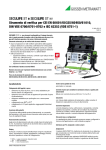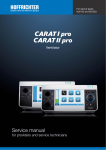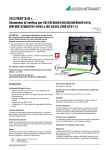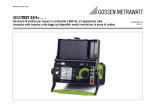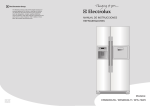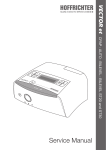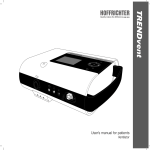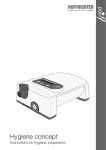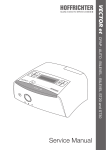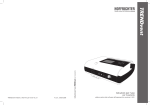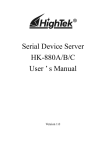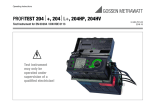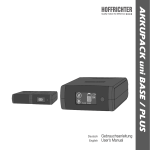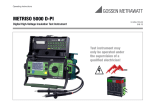Download TRENDvent Service ENG_2015-02-04_09.indd
Transcript
TRENDvent Service Manual Ventilator CONTENTS 1 Symbols used in this service manual ..............................................................................4 2 Safety information ...........................................................................................................4 3 3.1 3.1.1 3.2 3.3 3.4 Maintenance, repair and safety-related check ...............................................................5 Maintenance.....................................................................................................................5 Maintenance schedule .....................................................................................................5 Repairs.............................................................................................................................6 Hygienic preparation .........................................................................................................6 Safety-related check .........................................................................................................6 4 4.1 4.2 4.3 4.4 4.5 4.6 4.7 4.8 4.9 4.10 4.10.1 4.11 4.11.1 Description of device.......................................................................................................7 Housing, display and control elements ..............................................................................7 Operating unit...................................................................................................................9 Exploded view - General layout .......................................................................................10 Exploded view - Housing upper part ...............................................................................11 Exploded view - Front panel ...........................................................................................12 Exploded view - Back part ..............................................................................................12 Exploded view - Air outlet unit.........................................................................................13 Exploded view - Battery pack .........................................................................................13 Cable connecting plan PCB controller .............................................................................14 Tube connecting plan .....................................................................................................15 For devices up to serial number CAI1300550 ..................................................................15 Tube connecting plan .....................................................................................................16 For devices as of serial number CAI1300551 ..................................................................16 5 5.1 5.1.1 5.1.2 5.2 5.3 5.4 5.5 5.6 5.7 5.8 Important components ..................................................................................................17 Block diagrams ..............................................................................................................17 Block diagram of compressed air distribution ..................................................................17 Block diagram of entire device ........................................................................................18 Blower............................................................................................................................18 PCB DC-communication ................................................................................................18 Sensors / Valves (distribution of the compressed air) ........................................................18 Power supply .................................................................................................................19 PCB controller (Control- and operating unit) ....................................................................19 Operating unit / Display ...................................................................................................19 Interfaces .......................................................................................................................19 6 6.1 6.2 Battery maintenance .....................................................................................................19 Perform the battery quick test .........................................................................................19 Charging the batteries ....................................................................................................19 7 7.1 7.1.1 7.1.2 7.1.3 7.1.4 7.2 7.3 7.4 Servicing .......................................................................................................................20 Preliminary steps ............................................................................................................20 Tools and measuring equipment .....................................................................................20 Unpacking and disinfecting .............................................................................................21 Checking for external damage ........................................................................................21 Data backup...................................................................................................................21 Opening and disassembling the device ...........................................................................21 Cleaning .........................................................................................................................22 Check the silicone tubes .................................................................................................22 -2- 7.5 7.6 7.7 7.8 7.9 7.10 Check the cables and connections .................................................................................22 Changing the 9V rechargeable battery ............................................................................22 Changing the batteries....................................................................................................23 Changing the filters .........................................................................................................23 Exchanging the blower box.............................................................................................23 Assembling and closing the device .................................................................................25 8 8.1 8.2 8.3 8.4 8.6 8.7 8.8 Functional test ...............................................................................................................26 Checking the acoustic alarm ...........................................................................................26 Checking the alarm button light ......................................................................................26 Checking the display ......................................................................................................26 Checking the status screen for errors ..............................................................................26 Checking the “Battery operation” alarm...........................................................................26 Checking the leakage alarm ............................................................................................26 Checking “Frequency too high” alarm .............................................................................26 9 9.1 9.1.1 9.1.2 9.1.3 9.2 9.3 9.4 9.5 9.6 Device settings/tests .....................................................................................................27 Flow sensor calibration ...................................................................................................27 Measurement setup ........................................................................................................27 Manual flow sensor calibration ........................................................................................27 Automatic flow sensor calibration ....................................................................................28 Tightness test .................................................................................................................28 O2 valve test ..................................................................................................................29 Battery test.....................................................................................................................30 Setting the device back to factory settings ......................................................................30 Check the electrical safety of the external power supply ..................................................31 10 Final works ....................................................................................................................31 11 11.1 11.2 Maintenance kits, spare part list....................................................................................32 Maintenance kits ...........................................................................................................32 Spare part list .................................................................................................................33 12 12.1 12.2 12.3 12.4 Disposal ........................................................................................................................35 Device and components .................................................................................................35 Packaging ......................................................................................................................35 Batteries .........................................................................................................................35 Oxygen sensor ...............................................................................................................35 13 13.1 13.1.1 13.1.2 13.1.3 13.2 13.2.1 13.2.2 Shipping instructions .....................................................................................................36 Shipping instructions for contaminated medical technology ............................................36 Pick-Up ..........................................................................................................................36 Packaging for shipping ...................................................................................................36 Shipping .........................................................................................................................36 Shipping devices after maintenance or repairs ................................................................36 Packaging for shipping ...................................................................................................36 Shipping .........................................................................................................................36 -3- 1 SYMBOLS USED IN THIS SERVICE MANUAL Important information is denoted by symbols in this service manual. Be sure to follow these instructions in order to avoid accidents, personal injury and material damage. In addition, the local accident prevention regulations and general safety regulations in force in the area of use must be observed. This symbol denotes general safety instructions. Follow these instructions to avoid accidents, personal injury or material damage. This symbol denotes hazardous situations that may lead to serious injuries or death. This symbol denotes hazardous situations that may lead to moderately severe injuries. This symbol denotes situations that may lead to material damage or damage to the device. This symbol denotes information, tips and instructions for the efficient, error-free use of the device. 2 SAFETY INFORMATION • Before you start with the maintenance, fully read and understand the contents of this Service Manual. • There is a danger of short-circuiting of the capacitors and battery, even when no electrical power is applied to the device. If the main switch is switched off and the power supply is connected, the internal battery is charged, electrical power is still applied to the device! • Repair and maintenance tasks may only be carried out by suitably qualified, authorized and competent personal. • Oxygen sensors contain a caustic liquid. Avoid skin or eye contact if there is a sensor leak! • For oxygen sensors no adjustment or repair work is required. • Components carrying oxygen must not come into contact with oils or fats. There is a risk for fire and explosion. • For hygienic reasons, it is recommended to wear disposable gloves when you carry out a task on the device. Before the next tasks, please wipe the device with a commercial disinfecting solution, e.g. Mikrozid® Liquid. • The documents delivered with the device must be checked when the device arrives at the Service department. Should anything point to contamination of the device (e.g., MRSA), this device should be treated separately, according to the TRENDvent hygiene concept (transport, storage, processing). • Special hygienic measures are necessary when a maintenance or repair task is carried out on a machine contaminated by MRSA (Methicillin Resistant Staphylococcus Aureus). In all circumstances, protective clothing must be worn, such as gloves, lab coat and face mask. Please refer to the TRENDvent hygiene concept for further information on the handling of MRSA-contaminated devices -4- 3 MAINTENANCE, REPAIR AND SAFETY-RELATED CHECK All procedures performed are to be recorded. 3.1 MAINTENANCE The ventilator should be serviced, in accordance with the maintenance schedule, by an authorized service agency. 3.1.1 MAINTENANCE SCHEDULE Maintenance interval Action required Page Weekly Clean the air filters (coarse filter) Monthly, or earlier in case of heavy contamination Replace the air filters (coarse and fine filter) Every 6 months Carry out battery quick test 19 Every 6 months during storage Charging the batteries 19 Every 12 months (Maintenance kit 1) Opening and disassembling the device Cleaning and disinfection Check the silicone tubes Check the cables and connections Changing the 9V rechargeable battery Assembling and closing the device Changing the filters Flow sensor calibration Tightness test O2 valve test Check the electrical safety of the external power supply Safety-related check Documentation 21 22 22 22 22 25 23 27 28 29 31 6 31 Every 2 years (Maintenance kit 2a or 2b) Changing the internal batteries Changing the battery pack without PCB (with battery test) or Changing the battery pack with PCB (without battery test) Safety-related check Documentation Every 15000 h blower run time or every 5 years or displaying in the device or displaying via bargraph in VENTcontrol (Maintenance kit 5) Exchanging the blower box Flow sensor calibration Tightness test O2 valve test Setting the device back to factory settings Safety-related check Documentation 23 6 31 23 27 28 29 30 6 31 Table 1: Maintenance intervals Additional work Action required Page Before every recommissioning Safety-related check Documentation When changing patients, prepa- Hygienic preparation, in accordance with the TRENDvent hygiene ration, the preparation of conconcept taminated devices (e.g., MRSA) Table 2: Additional work -5- 6 31 3.2 REPAIRS Repairs to the device may only be carried out by an authorized service agency. The following should be carried out in the case of a repair: • Wipe disinfect the device surface, e.g., Mikrozid® Liquid • Check the error description and error analysis • Carry out the repairs • Final inspection consisting of: – Safety-related test (see section 3.4 on page 6) – Checking the electrical safety of the power supply (see section 9.6 on page 31) – Final work (section 10 on page 31) • Packaging of the device according to the packing instructions in section 13.2.1 on page 36 • Shipping according to the shipping instructions in section 13.2.2 on page 36 3.3 HYGIENIC PREPARATION During preparation, preparation on changing patients, as well as preparation after contamination (e.g., MRSA), the device should be treated according to the TRENDvent hygiene concept. 3.4 SAFETY-RELATED CHECK The safety-related check must be carried annually, after repairs and before every recommissioning. This consists of: • a visual inspection of the device (for external damage) • a functional check (see page 26) • a visual inspection of the accessories, in accordance with the manufacturer’s instructions (respiratory tubes, oxygen sensor, etc.) The safety-related check carried out must be documented. -6- 4 4.1 DESCRIPTION OF DEVICE HOUSING, DISPLAY AND CONTROL ELEMENTS Display Operating unit Unlocking button for humidifier G1 Connection for tube system/ humidifier Contact sockets for humidifier Handle Oxygen sensor cable connection (jack = 2.5 mm) G2 Control tube connection (ø = 4.5 mm) G3 G4 Oxygen connection G5 Pressure measuring tube connection (ø = 3.5 mm) Figure 1: Front view of device -7- Oxygen output G6 Check valve Tube system switch Sign for power supply Main switch DC Mains socket 24V~/5A Com Service connection Remote alarm LED (RS232 interface, RJ11 6/4) Remote alarm connection (RJ10 4/4) Air inlet with integrated filter cassette (fine and coarse filter), detachable PC connection (USB interface, Typ B) Connection cover Figure 2: Rear view of device G7 Fine filter Figure 3: Holder filter cassette -8- 4.2 OPERATING UNIT Power LED Battery LED esc button Touch wheel with 4 cursor buttons OK button Alarm button Heating button ON/OFF button Figure 4: Operating unit elements -9- 4.3 EXPLODED VIEW - GENERAL LAYOUT A5 A6 Inner frame complete A17 A4 Interior wall A7 Side housing part without handle A2 Air outlet with A3 Bellows air inlet straight A8 Back part assembled Blower Box K10 flow element C6 Housing upper part, complete Motor cable Control valve with cable A1 Front panel A16 A10 Bellows air outlet, angled A15 Cover, check valve A11 A14 A12 4x Lens head screw for housing (M3 x 8) Figure 5: Exploded view - General layout - 10 - PCB, controller Side housing part with handle Battery pack complete Housing lower part, complete A13 A9 4x Housing foot 4.4 EXPLODED VIEW - HOUSING UPPER PART B1 B2 B3 Label band Operation panel K1 Seal operation panel B4 Display K2 B5 Ribbon cable operation panel Ribbon cable display 3x Screws M2x3 B6 B7 Figure 6: Exploded view - Housing upper part - 11 - Housing upper part 8x Hexagonal nuts M2.5 4.5 EXPLODED VIEW - FRONT PANEL C6 C2 Control valve With cable Piezo signal transmitter with PCB and cable K3 K9 Signal transmitter cable C4 K4 C1 Cable O2 sensor O2 valve with cable Front panel K5 C3 C5 Control valve cable O2 valve cable O2 block O2 connector Figure 7: Exploded view - Front panel 4.6 EXPLODED VIEW - BACK PART D1 PCB, DC-communication D2 Back part D3 Holder for filter cassette D4 D9 4x Lens head screw 2.2x6.5 D8 D10 Seal back wall D7 Figure 8: Filter cassette Main switch D6 DC port Exploded view - Back part - 12 - D5 Cover for connectors Coarse filter 4.7 K6 EXPLODED VIEW - AIR OUTLET UNIT Proportional valve cable E9 Proportional valve with cable E10 Spring E1 E8 Air outlet without humidifier cable E2 Humidifier unlock key O-ring E4 E7 4.8 Seal flow element Flow element E5 Seal air-outlet E6 Figure 9: E3 Humidifier cable, assembled K7 Temperature sensor cable Exploded view - Air outlet unit EXPLODED VIEW - BATTERY PACK F1 F2 2x Screws 2.2x6.5 Half of casing F3 PCB, Battery charging K8 Cable battery pack F1 F4 Internal battery pack (1 set) Figure 10: Exploded view - Battery pack - 13 - Half of casing Holder flow element 4.9 CABLE CONNECTING PLAN PCB CONTROLLER Connection E6 Cable humidifier Connection K7 Cable temperature sensor Connection K3 Cable signal transmitter Connection K6 Cable proportional valve Connection K5 Cable O2 valve K9 Cable control valve Connection K4 Cable O2 sensor Figure 11: Cable connection plan PCB Controller - 14 - 4.10 TUBE CONNECTING PLAN 4.10.1 FOR DEVICES UP TO SERIAL NUMBER CAI1300550 A9 PCB Controller E5 E-Block 9V A16 Holder flow element Bellows air outlet E9 Proportional valve C6 Control valve B A View B Sinter element View A C4 Oxygen valve A1 Front panel blue1 brown red1 green grey white black no color no color 1 incl. sinter element Figure 12: Tube connecting plan for devices up to serial number CAI1300550 - 15 - 4.11 TUBE CONNECTING PLAN 4.11.1 FOR DEVICES AS OF SERIAL NUMBER CAI1300551 A9 PCB Controller E5 E-Block 9V A16 Holder flow element Bellows air outlet E9 Proportional valve C6 Control valve B A View B Sinter element View A C4 Oxygen valve A1 Front panel blue1 brown red1 green grey white black no color no color 1 incl. sinter element Figure 13: Tube connecting plan for devices as of serial number CAI1300551 - 16 - 5 IMPORTANT COMPONENTS The TRENDvent ventilator comprises the following components: • Blower • PCB, DC-communication • Sensors / valves (compressed air distribution) • Power supply • PCB Controller (control and operating unit) • Interfaces 5.1 BLOCK DIAGRAMS 5.1.1 BLOCK DIAGRAM OF COMPRESSED AIR DISTRIBUTION Air inlet Filter Switch Control unit Check valve Blower O2 valve Flow sensor Proportional valve Pressure sensors/excess Pressure switch Control valve Oxygen connection Air outlet Control tube connection Pressure measuring tube connection Figure 14: Block diagram of compressed air distribution - 17 - 5.1.2 BLOCK DIAGRAM OF ENTIRE DEVICE Switching power supply 100 ... 240 V AC (-20%, +10%) Remote alarm Nurse call Accessories PC PCB, DC-communication PCB Controller (control and operating unit) Blower Humidifier Tube system Internal battery Sensors / Valves Oxygen supply Controls / Display Figure 15: Block diagram of entire device 5.2 BLOWER The blower provides a maximum pressure of 40 hPa at a flow of 200 l/min. It is installed in a sound insulated box. On the air inlet side there is an air filter cassette with a coarse and a fine filter. 5.3 PCB DC-COMMUNICATION The DC-communication printed circuit board enables the connection to the external power supply (power supply unit or battery pack), via the power interface, as well as the connection of accessories/remote alarm/PC via the communication interfaces (RS232, USB2.0). The appliance switch is also located on this PCB. Furthermore, the PCB also accommodates the motor controller with the accompanying block-commutation circuit. A reed switch switches between the respiratory therapy and ventilation modes. 5.4 SENSORS / VALVES (DISTRIBUTION OF THE COMPRESSED AIR) For the distribution of the compressed air, the device is composed of the following units: • Blower (40 hPa at 200 l/min) • Air outlet (standardized tube connector [M22]) with flow element and proportional valve • Check valve • Control valve • Oxygen block including 3/2 directional valve and self-locking connection • Pressure measuring tube connection ( = 3.5 mm) • Control pressure tube connection ( = 4.5 mm) • Connection for oxygen sensor (jack 2.5 mm) - 18 - 5.5 POWER SUPPLY The device is supplied with power via an AC/DC switching power supply or the internal battery. The device can also be provided with an external power supply using the AKKUPACK uni. Ask your specialist dealer about this. 5.6 PCB CONTROLLER (CONTROL- AND OPERATING UNIT) The controller PCB is the main structural element of the device. It contains the controllers for operation and controls, the sensors (pressure/temperature), components for measuring voltage and current, for acoustic and visual alarms and the generation of supply voltage. 5.7 OPERATING UNIT / DISPLAY The operating unit is made of float glass and is 202 x 110 mm in size. The material is approx. 3 mm thick. All elements are described in Figure 4 on page 9. The display is 81 x 61 mm in size and has a resolution of 320 x 240 pixels. 5.8 INTERFACES The device has an USB interface for connection to a PC. This interface enables the PC software VENTcontrol to be used to communicate with the device and software updates can be carried out. There is also a connection for the nurse call or a remote alarm box. For the flow sensor calibration, the device has an RS232 interface. 6 6.1 BATTERY MAINTENANCE PERFORM THE BATTERY QUICK TEST The battery quick test verifies whether the device in case of a power failure can be operated on battery for at least one hour. When the device is used the battery quick test must be performed out by the provider or user every 6 months. However, a monthly check is recommended. 1. Make sure that the batteries are fully charged (100%). 2 Disconnect the device from the mains and operate the device 1 hour on battery power. 3. The test is passed, if after 1 hour the battery capacity is > 10 % and the alarm “Internal Battery low“ has not occurred. If the battery capacity has gone below 10 % and the alarm „Internal Battery low” has occurred, the batteries must be replaced by an authorized service technician. 4. Charge the batteries up to 100 % by operating the devices via mains. 6.2 CHARGING THE BATTERIES During the storage, charge the batteries every 6 months up to 100 % capacity, by operating the devices via mains. - 19 - 7 SERVICING 7.1 PRELIMINARY STEPS 7.1.1 TOOLS AND MEASURING EQUIPMENT To carry out maintenance, the tools and equipment are required as follows: • Respiratory device TRENDvent • Valve tube system • Test lung with following specifications: – Compliance: 25 ml/mbar – Vt = 500 ml, PEEP = 0 mbar – Resistance: 20 mbar/l/s – Tidal volume: max. 1000 ml • Screwdriver, long (Phillips-tip PH1 x 200) • Side cutter • Compressed air supply or stationary compressed air connection • Soft brush and vacuum cleaner • Soft underlay • Disposable gloves • TRENDvent power supply (art. no.: 0001 4206) and mains cable (art. no.: 3110 0023) • Airflow Pressure Meter (0-200 l/min, e.g. HOFFRICHTER APM, art. no.: 0000 4832) • Adapter for flow sensor calibration (art. no.: 0000 4946 ) • Adapter for oxygen connection, straight (art. no.: 4100 0104) • RS232 connection cable • Airflow resistor 7 mm (art. no.: 0000 7305) • Blind plug APM (art. no.: 0000 4831) • PC with following system requirements (minimum requirements): – MS-Windows® XP, Vista or 7 – AMD Athlon/ Pentium Class (x86), operating frequency > 700 MHz – 512 MB RAM (recommended) – at least 400 MB free hard disc space – Microsoft .NET Framework 2.0 Redistributable (x86) – 2 MB graphics card with at least High Color (16 Bit) – Mouse – one available serial interface + USB Port • USB cable • HOFFRICHTER PC-Software VENTcontrol (art.-Nr.: 0001 4876) • Spray disinfectant • Device to check the electrical safety (e.g. SECUTEST SIII/DIN EN 62353:2008) • Service manual, user’s manual All tools, measuring equipment and aids possibly exposed to contamination must be cleaned after they have been used and treated with disinfectant. - 20 - 7.1.2 UNPACKING AND DISINFECTING To protect against germs, the surface of the device and, where present, the humidifier must be treated with a disinfectant immediately after unpacking. 7.1.3 CHECKING FOR EXTERNAL DAMAGE Before starting the service works, check the device for external damage. 7.1.4 DATA BACKUP We recommend that a backup is carried out before starting maintenance work. Connect the device to a PC and use VENTcontrol to read out and save the device data. Notes on the following sections of text: The numbers in brackets designate the position numbers according to the exploded drawings (section 4.3 on page 10 to section 4.10 on page 15), and the spare parts list (section 11.2 on page 33). 7.2 OPENING AND DISASSEMBLING THE DEVICE During the maintenance work, check for any moisture in the device. Damp areas should be wiped and disinfected. Before assembly, ensure that the affected areas are sufficiently dry. 5. Switch off the device using the main switch and disconnect it from the mains power, as well as all connected components (e.g., humidifier). 6. Remove the filter cassette holder (D3). 7. Place the device with the upper side on a soft surface. 8. If the HOFFRICHTER warranty seal is still in place, remove it. 9. Unscrew the four screws on the underside of the device using a long screwdriver (Phillips-tip PH1 x 200). 10. Lift off the lower part of the housing (A14). Ensure that the screws do not fall out and are lost. 11. Remove both lateral housing parts (A4 + A10). 12. 13. Detach the battery pack (A11) from the controller PCB (A9) by pulling the battery charging PCB (F3) away from the controller PCB. Detach the controller PCB (A9) from the DC-communication PCB (D1). 14. Tilt the housing’s back part (A8) outwards and pull the motor cable off from the DC-communication PCB (D1). 15. Remove the back part (A8). 16. Dismantle the cover for the check valve (A15). Take care to avoid breaking the tabs off. - 21 - 7.3 CLEANING 1. Carefully clean the interior using the brush and vacuum cleaner. 2. Clean areas that are difficult to access using compressed air. Then remove any loose particles using the vacuum cleaner. 3. Remove any stubborn soiling from the interior and exterior of the upper and lower parts using a cloth, which has been moistened with a mild soap solution. 4. If a humidifier is present, wash out the water container and spray-disinfect it. Treat stubborn calcification with 5 % vinegar solution. 7.4 CHECK THE SILICONE TUBES Check every silicone tube used in the device for signs of mechanical damage, ageing and for correct seating and, if necessary replace acc. to tube connecting plan (see Figure 12 on page 15): • Oxygen connection tubes on the blower box (A3) and the O2 block (C3) • Pressure measuring tubes on the pressure sensors • Pressure measuring tubes on the flow element holder (E5) • Excess pressure tube on the pressure switch and air outlet (E1) • Tubes on the control valve (C6) 7.5 CHECK THE CABLES AND CONNECTIONS Check every connecting and supply cable for correct seating and signs of damage. If necessary correct or replace: • Ribbon cable operation panel (K1) • Ribbon cable display (K2) • Cable signal transmitter (K3) • Cable oxygen sensor (K4) • Cable oxygen valve (K5) • Cable proportional valve (K6) • Ribbon cable temperature sensor (K7) • Cable battery pack (K8) • Cable control valve (K9) • Cable humidifier connection (E6) • Motor cable (K10) 7.6 CHANGING THE 9V RECHARGEABLE BATTERY The 9V rechargeable battery is included in the Maintenance kit 1 and should be changed annually. Change the 9V rechargeable battery, after the device has been disassembled, as follows: 1. Cut the cable tie. 2. Remove the 9V rechargeable battery from the holder. 3. Insert a new battery (Ni-MH; HR 8.4 V/200 mAh). Ensure that the polarity and the fit in the holder are correct. 4. Affix the 9V rechargeable battery to the PCB controller (A9) using the cable tie (142 mm) included in Maintenance kit 1. Cut off the cable tie’s protruding end section with a side cutter. - 22 - 7.7 CHANGING THE BATTERIES The person responsible for carrying out the maintenance should decide whether, for the sake of simplicity, the entire internal battery pack with PCB should be changed. If only changing the battery pack without PCB, proceed as follows: 1. Pull the battery pack cable (F8) from the battery charging PCB (F3). 2. Loosen the two screws (F2) on the battery charging PCB. 3. Lift the clip fasteners at the top and bottom of the housing using a screwdriver or similar tool and push the two halves of the housing (F1) apart. 4. Take both of the batteries out of the housing. 5. Insert the new batteries into the housing. Take care that the batteries on one side are somewhat raised and are correctly fitted and that cables are not trapped or squeezed. 6. Push the two halves of the housing together. 7. Plug the battery pack cable onto the battery charging PCB. 8. Fix the battery charging PCB to the housing using the two screws. 9. Perform a battery test. When using new batteries without a PCB (art. no. 1600 0015), a battery test must be performed (see section 9.4) after assembling the device. 7.8 CHANGING THE FILTERS 1. Pull the filter cassette holder (D3) from the device. 2. Slide the filter cassette out from the filter cassette holder (D4). 3. Remove the coarse filter (black, D10). 4. Remove the fine filter (white, G7). 5. Insert a new coarse filter, followed by a new fine filter, into the filter cassette. 7.9 EXCHANGING THE BLOWER BOX The blower box is contained in Maintenance kit 5 and should be exchanged after a runtime of 15000 hours or every 5 years or displaying in the device or displaying via bargraph in VENTcontrol. Open and disassemble the device according to section 7.2 and subsequently complete the following steps: 1. Press the ferrite core out of the retaining clip. 2. Disconnect all cables and tubes from the PCB controller (A9) in the following order: 3. – Ribbon cable temperature sensor (K7) – Cable humidifier connection (E6) – Cable proportional valve (K6) – Cable oxygen valve (K5) / Cable control valve (K9) – Cable signal transmitter (K3) – Cable oxygen sensor (K4) – All tubes (While doing that, hold the pressure sensors tightly to avoid damaging their pins.) – Ribbon cable operation panel (K1) – Ribbon cable display (K2) Pull off the O2 connection tube from the blower box and dispose of it. - 23 - 4. Remove the 3 cable ties and dispose of them. 5. Pull the tube with the white marking off of the front panel. 6. Lift out the inner frame (A5) and set it down, somewhat offset. 7. Pull off the bellows (A16) from blower box (A3) and flow element holder (E5) and dispose of the cable tie. 8. Pull the motor cable (K10) through the opening of the inner frame and remove the blower box from the inner frame. 9. Pull off the bellows (A7) from the blower box (A3) and dispose of the cable tie. 10. Take the new blower box and fit the bellows (A7) to the air inlet and fit the bellows (A16) to the air outlet. Ensure that the bellows with the slots sit correctly in the blower box. 11. Insert the new blower box into the inner frame and, at the same time, feed the motor cable (K10) through the opening in the inner frame. Ensure that the bellows (A7) with the slot sit correctly in the inner frame. 12. Pull the motor cable upwards in the slit at the back of the inner frame. 13. Slip the angled air outlet bellows (A16) onto the flow element holder (E5). 14. Fasten the bellows with the 142 mm cable tie (Maintenance kit 5). Cut off the cable tie’s protruding end section with a side cutter. 15. Place the inner frame onto the upper part of the housing (A6). Ensure that the inner frame sits exactly in the corresponding guides and no tubes get squeezed. 16. Take the front panel and plug the O2 connection tube (no color, +) onto the blower box according to the tube connecting plan (see Figure 12 on page 15). Fasten the O2 connection tube with the 71 mm cable tie (Maintenance kit 5). Cut off the protruding end section with a side cutter. 17. Tie up the signal transmitter cable (K3), proportional valve cable (K6) and control valve cable (K9) on the air outlet’s right-hand side with a cable tie (71 mm, Maintenance kit 5). 18. Place those three cables into the slender cable run on top of the air outlet unit. Then tie them together with the humidifier cable (E6) on the left-hand side of the air outlet using a cable tie (71 mm, Maintenance kit 5). 19. Affix the whole cable harness together with the temperature sensor cable (K7) to the fixing base at the top of the flow element holder using a cable tie (71 mm, Maintenance kit 5). Make sure not to squeeze the temperature sensor cable (K7) by overtightening the cable tie. 20. Cut off the protruding cable tie end sections with a side cutter. 21. Press the ferrite core into the retaining clip on the inner frame. 22. Connect the O2 valve cable (K5) to the control valve cable (K9). Ensure the correct polarity. 23. Plug the tube with the white marking onto the control tube connection (white) on the inner side of the front panel. 24. Take the PCB controller (A9) and reconnect all cables and tubes according to the cable and tube connecting plans. While connecting the tubes, hold the pressure sensors tightly to avoid damaging their pins. 25. The further assembly is described in section 7.10. - 24 - 7.10 ASSEMBLING AND CLOSING THE DEVICE 1. Take the housing’s back part (A8) and connect the motor cable (K10) with the DC-communication PCB (D1). 2. Fit the housing’s back part (A8) into the housing’s upper part (A6). 3. Connect the controller PCB (A9) and the back part (A8) with the DC-communication PCB and position the controller PCB into the corresponding guides in the upper part of the housing (A6). Check the position and fit of the back part. 4. Fit the cover for the check valve. Ensure that the fastening tabs on both sides snap in audibly and that the interior wall (A17) sits behind the cover for the check valve. It should also be ensured that the cover fit exactly onto the slot of the bellows (A7). 5. Fit the battery pack and connect the battery pack PCB (F3) to the controller PCB (A9). 6. Insert both lateral housing parts (A4 + A10). Ensure that they sit correctly in the guides. 7. Finally, check that all components and connections fit correctly. 8. Fit the lower part (A14) and securely tighten all four screws (A13). Ensure that none of the cables and tubes are squeezed. 9. Insert the filter cassette holder (D3, with new filters) into the back part (A8). - 25 - 8 FUNCTIONAL TEST Until all tests have been passed, the device must not be used. The tube system and a test lung are required for the functional test. 1. Connect the tube system and the test lung to the ventilator. 2. Connect the device to the mains power. 3. Switch the ventilator on. 4. Start ventilation by pressing the ON/OFF key. 8.1 CHECKING THE ACOUSTIC ALARM Switch the ventilator on using the main switch on the rear of the device. A signal must sound. 8.2 CHECKING THE ALARM BUTTON LIGHT After the device is started, it carries out a self-test of the alarm button. The button must light up in the following order: white > red > yellow > white. The light subsequently goes out. 8.3 CHECKING THE DISPLAY Switch through all screens in the physician- and patient mode and check that all display elements are present and legible and that the display’s lighting is functioning. If necessary, check the “Contrast” and “Brightness” settings“. 8.4 CHECKING THE STATUS SCREEN FOR ERRORS When the device is started, it carries out a self-test. If any errors are detected, the status screen is automatically displayed. Faulty parameters will be displayed by “ERROR”. Possible errors must first be corrected before the device can be used. 8.5 CHECKING THE DATE AND TIME Switch to the comfort screen and check the date and time. If necessary, correct the setting. 8.6 CHECKING THE “BATTERY OPERATION” ALARM Remove the device from the mains power. An alarm must sound and the message “Battery Operation” must appear in the display. 8.7 CHECKING THE LEAKAGE ALARM Remove the test lung from the device. After at most 15 seconds, an alarm must sound and the message “Leakage” must appear in the display. 8.8 CHECKING “FREQUENCY TOO HIGH” ALARM Connect the test lung to the TRENDvent. Change to the physician mode and select PSV as the ventilation mode. Set the frequency to 12 bpm and the alarm parameter “Max. Frequency” to 20 bpm. Start ventilation. Simulate an increased respiration rate by squeezing the test lung, until the alarm sound is triggered and the message “Frequency too high” appears on the display. - 26 - 9 9.1 DEVICE SETTINGS/TESTS FLOW SENSOR CALIBRATION The flow sensor calibration should be carried out as part of the annual maintenance or after the repair of relevant components. This can be done automatically or manually. The flow sensor calibration should be carried out with a flow resistance of 7 mm. 9.1.1 MEASUREMENT SETUP RS232 connection cable Airflow Pressure Meter (APM) TRENDvent Adapter for flow sensor calibration Flow sensor Airflow resistor 7 mm Figure 16: Measurement setup flow sensor calibration 9.1.2 MANUAL FLOW SENSOR CALIBRATION 1. Connect the flow sensor, airflow resistor, adapter and TRENDvent (see Figure 16 on page 27). 2. Activate the Clinic mode. 3. Activate the Service screen using the 4. Select “Flow sensor calibration” using the 5. Press the OK button. 6. Enter the PIN code 1302 using the cursor key or touch wheel. Pressing the Ok button switches to the next number, respectively. 7. The flow sensor calibration is performed at 0, 10, 20, 40, 60, 80, 100, 120 and 160 l/min. Pressing the esc button aborts the flow sensor calibration. or cursor key. cursor key or touch wheel. - 27 - 9.1.3 AUTOMATIC FLOW SENSOR CALIBRATION 1. Connect the flow measurement device to the TRENDvent using the RS232 connection cable (see Figure 16 on page 27). 2. Connect the flow sensor, airflow resistor, adapter and TRENDvent (see Figure 16 on page 27). 3. Activate the Clinic mode. 4. Activate the Service screen using the 5. Select “Flow sensor calibration > automatic” using the 6. Press the OK button. 7. Enter the PIN code 1302 using the cursor keys or touch wheel. Pressing the OK button switches to the next number, respectively. 8. The flow sensor calibration starts automatically. Pressing the esc button aborts the flow sensor calibration. 9.2 or cursor key. cursor key or touch wheel. TIGHTNESS TEST The tightness test should be carried out as part of the annual maintenance or after the repair of relevant components. The tightness test has 2 functions: • • Testing the connected tube system and the device for leaks Functional testing of the excess pressure switch Carry out the tightness test as follows: 1. Seal the connection for the tube system with the blind plug APM (art-no. 0000 4831). 2. Connect the short tube of the blind plug APM to the control tube connection ( tube to the pressure measuring tube connection ( ). 3. Connect the device to the mains power. 4. Switch the device on. 5. Activate the Clinic mode. 6. Activate the Service screen using the 7. Select “Tightness test” using the 8. Press the OK button. 9. Enter the PIN code 1302 using the cursor keys or touch wheel. Pressing the OK button switches to the next number, respectively. or ) and the long cursor key. cursor key or touch wheel. 10. The tightness test is started. The current pressure and current flow are displayed. The pressure is first increased to 50 hPa and a test is run to see whether the pressure at this value stays constant for a few seconds. The pressure is subsequently increased further to 60 hPa. If a value over 60 hPa is measured, the excess pressure switch switches the device off and an error message for the pressure sensor is displayed in the status screen. In this case, please contact HOFFRICHTER. In the case of a pressure sensor error, the device must not be used. 11. Monitor the flow value during the tightness test. At values over 3 l/min, there may be a leak in the tube system and it should be replaced. - 28 - 9.3 O2 VALVE TEST The O2 valve test should be carried out as part of the annual maintenance or after the repair of relevant components. If it has been assured that the device is exclusively used without an oxygen supply, the O2 test can be omitted. During the O2 valve test, a tube system must not be connected to the device. It should furthermore be noted that ventilation is switched off. We recommend that a flow sensor calibration is carried out before the O2 valve test. The O2 valve test checks that the O2 valve is functioning properly. Carry out the O2 valve test as follows: 1. Connect the device to the mains power. 2. Connect the tube from the oxygen source to the oxygen connection adapter. 3. Insert the O2 connection adapter into the oxygen connection ( ). Only the O2 connection adapter supplied may be used to connect oxygen. Otherwise, there is a risk that the back-stop in the connection is damaged. Fats or oils must not be used as lubricants in the area around the O2 connection. There is a risk for fire and explosion. 4. Switch the device on. 5. Activate the Clinic mode. 6. Activate the Service screen using the 7. Select “O2 Valve Check” using the 8. Press the OK button. 9. Enter the PIN code 1302 using the cursor keys or touch wheel. Pressing the OK button switches to the next number, respectively. 10. The O2 valve test is started. The current pressure and current flow are displayed. The flow value must correspond approximately with the value at which the oxygen is introduced. If the flow value displayed is lower or zero, then the O2 valve is not working properly. The same applies if the pressure value is larger than zero. or cursor key. cursor key or touch wheel. - 29 - 9.4 BATTERY TEST If the maintenance of the device is carried out in the workshop, we recommend that a test of the internal batteries is carried out. The battery test must be carried out every 2 years, as well as after changing the single batteries (maintenance kit 2a). The test takes max. 4 hours. For the battery test a tube system or other accessories must not be connected to the device. Carry out the battery test as follows. 1. Connect the device to the mains power. 2. Switch the device on. 3. Activate the Clinic mode. 4. Activate the Service screen using the 5. Select “Battery Check” using the 6. Press the OK button. 7. Enter the PIN code 1302 using the cursor keys or touch wheel. Pressing the OK button switches to the next number, respectively. 8. After the PIN code has been entered, the battery test, which consists of two phases, will start: or cursor key. cursor key or touch wheel. a. Phase 1: Battery is charged (max. 3 h depending on the battery’s charge status) b. Phase 2: Battery is discharged with a constant load (approx. 1 h) The display indicates the progress of the battery test as a percentage. After the 2nd phase has ended, the capacity of the battery is displayed. If the capacity is 80 %, the test is considered to be passed. If the capacity is lower or the message “ERROR” is displayed in the status screen, both batteries or the entire battery pack must be replaced. 9.5 SETTING THE DEVICE BACK TO FACTORY SETTINGS The device’s standard factory values can be found in the user’s manual. To reset the device to the factory settings, proceed as follows: 1. Activate the Service screen using the 2. Select “Factory settings” using the 3. Enter the PIN code 1302 using the cursor keys or touch wheel. Pressing the OK button switches to the next number, respectively. 4. After the PIN code has been entered, the device restarts. 5. The contrast setting (Set Contrast) is shown in the display. The display contains two bars, with black and white outer fields. The fields in the center should be medium gray (see figure). To set this, press to increase the contrast and to decrease the contrast. 6. Press the OK button. or cursor key. cursor key or touch wheel. If the contrast is not set within 1 minute, the device will sound an alarm up until the contrast is set. - 30 - 9.6 CHECK THE ELECTRICAL SAFETY OF THE EXTERNAL POWER SUPPLY Testing the electrical safety of the external power supply should be carried out as part of the annual maintenance and during repair work. General information The TRENDvent ventilation system consists of an external SK II power supply and the ventilator, which is operated at 24 V direct current. To meet the protection class II requirements, the ventilation system has been designed with a BF application part of the DIN standards EN 60601-1-A2:1995 and EN 60601-1:2006. Tests The tests are carried out by a device safety tester (e.g., SECUTEST SIII), working in accordance with the DIN EN 62353:2008 standard. The leakage currents should be determined by direct measurement. The ventilation system should be tested with a BF application part according to protection class II. The accompanying protection class II power supply is tested in the system. Any faults in the power supply are detected in the test of the entire system according to protection class II. Device leakage current The device leakage current is measured by the device safety tester (e.g., SECUTEST SIII) with a probe at the housing at the O2 sensor connection. The test is passed if the device leakage current limits comply with the standard DIN EN 623532008, Table 2. 10 FINAL WORKS All maintenance or repair work must be recorded. Furthermore, the “Service” checklist should be filled in and a testing seal, including the date and the tester’s mark, should be applied at a suitable place on the device. - 31 - 11 MAINTENANCE KITS, SPARE PART LIST 11.1 MAINTENANCE KITS Use the following kits for the various replacement and maintenance cycles: Maintenance kit 1 (art. no.: 0001 4984) - Every 12 months Quantity 1 1 1 1 Designation Rechargeable battery 9V Cover, check valve Coarse filter Fine filter Table 3: Maintenance kit 1 Maintenance kit 2a (art.-no.: 0001 4985) - Every 2 years Quantity 1 1 set Designation Maintenance kit 1 Internal rechargeable battery pack (Li-Ion) - without PCB, battery changing and housing (battery test necessary) Table 4: Maintenance kit 2a or Maintenance kit 2b (art.-no.: 0001 4987) - Every 2 years Quantity 1 1 set Designation Maintenance kit 1 Internal rechargeaable battery pack with housing and PCB, battery charging Table 5: Maintenance kit 2b Maintenance kit 5 (art. no.: 0001 4986) - After 15000 h blower runnning time or every 5 years or displaying in the device or displaying via bargraph in VENTcontrol Quantity 1 1 1 4 Designation Maintenance kit 1 Blower box Cable tie 142 mm Cable tie 71 mm Table 6: Maintenance kit 5 - 32 - 11.2 SPARE PART LIST Pos. A1 A2 A12 A13 A14 A15 A16 Designation Front panel assembled without oxygen block Air outlet with contact springs and flow element assembly set up to serial number CAI1300550 Air outlet with contact springs and flow element assembly set as of serial number CAI1300551 Blower Box Side housing part without handle Inner frame with foam, clips, check valve and magnet arm Housing upper part, complete without label band Bellows air inlet (straight) Back part assembled with PCB, DC-communication PCB, controller Side housing part with handle Internal rechargeaable battery pack with housing and PCB, battery charging Housing foot (single) 4x lens head screw M3x8 for housing, DIN 7985 Housing lower part, complete with housing foots and rating plate Cover, check valve Bellows air outlet (angled) with cable tie B1 B2 B3 B4 B5 B6 Label band “TRENDvent HOFFRICHTER” Operation panel with sealings and nuts Seal operation panel 179x1.4 Display 3x screws M2x3, DIN 7985 Housing upper part 2200 0098 0001 4145 --1520 0018 C1 C2 C3 C4 C5 C6 Front panel without O2 block Piezo signal transmitter with PCB and cable O2 block O2 valve with cable, assembled O2 connector Control valve 0001 4104 0001 4118 0001 4137 0001 4105 4100 0171 0001 4150 D1 D2 D3 D4 D5 D6 D7 D8 D9 PCB, DC-communication Back part without PCB, DC-communication with sticker “Warning hints” Holder for filter cassette Filter cassette, open, with filters Cover for connectors DC-port Main switch Seal back part 4x lens head screw 2.2x6.5, DIN 7981 0001 4327 0001 4103 4210 1005 0000 2038 4210 1035 3210 0041 3210 0040 ----- Air outlet with spring connectors glued O-ring 35x1.5 Seal air-outlet Humidifier-unlock key without spring Proportional valve with spring connectors, assembled, 24 V up to serial number CAI1300550 Proportional valve with spring connectors, assembled, 12 V as of serial number CAI1300551 Spring for humidifier-unlock key 0.6x 4.5x 15 0001 4133 4400 0027 4210 0222 0001 4140 0001 4107 A2 A3 A4 A5 A6 A7 A8 A9 A10 A11 E1 E2 E7 E8 E6 + E9 E6 + E9 E10 - 33 - Article number 0001 4104 0001 4110 0001 4153 0001 4505 4210 1019 0001 4109 0001 4102 4210 1032 0001 4328 0001 4143 0001 4139 0001 4333 4400 0073 4300 0072 0001 4101 4210 1009 0001 4146 0001 4102 0001 4127 4100 0102 Pos. F1 F2 F3 F4 Designation Housing for internal battery pack 2x screw 2.2x 6.5 DIN 7981 PCB, battery charging Internal rechargeable battery pack (Li-Ion) - without PCB, battery changing and housing (1 set) Article number 4210 1006 --0001 4330 1600 0015 Filter cassette, closed, with filters Ribbon cable 24 pol. for operation panel Cable flow calibration, assembled Sinter element Tube set (inner) with tube connecting plan up to serial number CAI1300550 Tube set (inner) with tube connecting plan as of serial number CAI1300551 Buchse für Sauerstoffanschlusskabel Rechargeable battery 9 V Pressure switch 60 mbar Lithium battery (cell) CR2032, 3 V Assembly set flow element (E4), 2x seal (E3), holder flow element, fastening element (E5), fixing base and cable tie Maintenance kit 1 Maintenance kit 2a Maintenance kit 2b Maintenance kit 5 Replacement kit 1 up to serial number CAI1300550 Replacement kit 2 up to serial number CAI1300550 Replacement kit 1.1 as of serial number CAI1300551 Replacement kit 2.1 as of serial number CAI1300551 0000 2058 3220 0089 0001 4112 4100 0173 0001 4108 0001 4125 0001 4136 1600 0017 2300 0036 1600 0004 0001 4147 Table 7: Spare parts list - 34 - 0001 4984 0001 4985 0001 4987 0001 4986 0001 4988 0001 4989 0001 4990 0001 4991 12 DISPOSAL Proper disposal saves natural resources and prevents harmful substances being released into the environment. 12.1 DEVICE AND COMPONENTS The device or components must not be disposed of with the household waste. They must be disposed of at a communal collection point or public waste-disposal authority. 12.2 PACKAGING The packaging can be disposed with the normal household waste. 12.3 BATTERIES Batteries must not be disposed of with the household waste. They must be disposed of at a local retailer or at a communal collection point. 12.4 OXYGEN SENSOR The oxygen sensor must not be disposed of with the household waste. It should be disposed of correctly by incineration in a hazardous waste incineration plant. Local official regulations should be observed. - 35 - 13 SHIPPING INSTRUCTIONS 13.1 SHIPPING INSTRUCTIONS FOR CONTAMINATED MEDICAL TECHNOLOGY The following shipping instructions apply to contaminated medical technology which is delivered to HOFFRICHTER GmbH for processing. 13.1.1 PICK-UP The dealer, medical technician or authorised personnel picks up the contaminated medical technology from the patient. A local surface disinfection of the equipment and accessories with microcide liquid spray (MRSA active) takes place followed by carefully placing the objects in bags with the use of disposable gloves, mask and disposable apron. The proper disposal of disposable materials is respected. 13.1.2 PACKAGING FOR SHIPPING The packaging of equipment/accessories in sterile welding foil followed by shrink wrap or packing in PVC or PE bags (tear resistant) and sealed by tape or tie wrap takes place at the dealer’s or in the service departments. Power cable, ventilation equipment, user’s manual and other accessories with minimal risk of infection must be properly disposed of. Hint: “CAUTION – CONTAMINATED EQUIPMENT’” or “CAUTION – MRSA-CONTAMINATED EQUIPMENT’” must be visibly placed on the packaging. The packaging must be proper and robust and must not be contaminated. The box is conscientiously sealed with packing tape. 13.1.3 SHIPPING The delivery note must be on the outside of the equipment packaging. (Notice on delivery note: “CAUTION – CONTAMINATED EQUIPMENT’’ or “CAUTION - MRSA-CONTAMINATED EQUIPMENT’’). Shipping takes place by appropriate logistics companies. 13.2 SHIPPING DEVICES AFTER MAINTENANCE OR REPAIRS The shipping instructions apply to medical technology, which is sent back to the customer or dealer by the Service department, after maintenance or repairs. 13.2.1 PACKAGING FOR SHIPPING The device is packaged in PVC or PE bags (tear proof). The bag must be sealed securely (e.g., tape or cable ties). The packaging must be proper and robust and must not be contaminated. The box should be sealed carefully with packing tape. 13.2.2 SHIPPING The accompanying documents must contain the following information, which must be visible to the recipient: Zu Ihrer Information! Dieses Gerät wurde nur oberflächendesinfiziert. Es erfolgte keine hygienische Aufbereitung. For your information! This device was disinfected only at the surface. There was no hygienic treatment. Shipping takes place by appropriate logistics companies. - 36 - HOFFRICHTER GmbH Mettenheimer Straße 12 / 14 19061 Schwerin Germany Phone: +49 385 39925 - 0 Fax: +49 385 39925 - 25 E-Mail: [email protected] www.hoffrichter.de TRENDvent Service ENG_2015-02-04_09






































